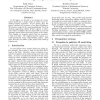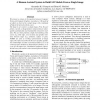133
Voted
ICASSP
2011
IEEE
14 years 4 months ago
2011
IEEE
There is an increasing number of methods for removing haze and fog from a single image. One of such methods is Dark Channel Prior (DCP). The goal of this paper is to develop a mat...
102
Voted
ACCV
2010
Springer
14 years 7 months ago
2010
Springer
This paper presents a novel approach for labeling objects based on multiple spatially-registered images of a scene. We argue that such a multi-view labeling approach is a better fi...
136
Voted
ICCV
2009
IEEE
14 years 10 months ago
2009
IEEE
Dense 3D reconstruction of extremely fast moving objects could contribute to various applications such as body structure analysis and accident avoidance and so on. The actual case...
130
Voted
PAMI
2002
15 years 7 days ago
2002
Images containing faces are essential to intelligent vision-based human computer interaction, and research efforts in face processing include face recognition, face tracking, pose ...
115
Voted
AMDO
2008
Springer
15 years 2 months ago
2008
Springer
Detection of humans and estimation of their 2D poses from a single image are challenging tasks. This is especially true when part of the observation is occluded. However, given a l...
137
Voted
ICPR
2000
IEEE
15 years 4 months ago
2000
IEEE
In this paper, we describe a new design of a recognition system for a single image of indoor scene including complex occlusions. In our system,
rst, the system estimates 3D struc...
119
Voted
CVPR
2006
IEEE
15 years 4 months ago
2006
IEEE
In this paper, we propose a method for determining the vignetting function given only a single image. Our method is designed to handle both textured and untextured regions in orde...
126
click to vote
ICMCS
1999
IEEE
15 years 4 months ago
1999
IEEE
We present a system at the junction between Computer Vision and Computer Graphics, to produce a 3-D model of an object as observed in a single image, with a minimum of high-level ...
118
Voted
SCIA
2009
Springer
15 years 5 months ago
2009
Springer
Features from the Scale Invariant Feature Transformation (SIFT) are widely used for matching between spatially or temporally displaced images. Recently a topology on the SIFT featu...
111
Voted
IWDW
2007
Springer
15 years 6 months ago
2007
Springer
The compositing of two or more people into a single image is a common form of manipulation. We describe how such composites can be detected by estimating a camera’s intrinsic par...




